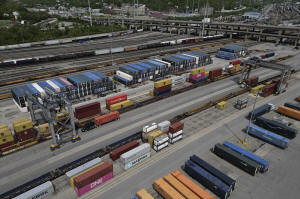Crucial exemption allows majority of Canadian and Mexican goods to be
shipped to US without tariffs
[August 06, 2025] By
ROB GILLIES
TORONTO (AP) — U.S. President Donald Trump raised the tariffs on
Canadian goods to 35% last week, but a key exemption for Canada and
Mexico shields the vast majority of goods from the punishing duties.
Goods that comply with the 2020 United States-Mexico-Canada Agreement
that Trump negotiated during his first term are excluded from the
tariffs.
Here's a look at Trump's tariffs on the two countries and their
exemptions:
Most Canadian exports reaching the US duty free
Canada’s central bank says 100% of energy exports and 95% of other
exports are compliant with the trade pact, known as USMCA. The Royal
Bank estimated that almost 90% of Canadian exports appear to have
accessed the U.S. market duty free in April.
Canadian Prime Minister Mark Carney said the commitment of the U.S. to
the core of USMCA, reaffirmed again last week, means the U.S. average
tariff rate on Canadian goods remains one of its lowest, and over 85% of
Canada-U.S. trade continues to be tariff free.
“Canada is better off than any of the trading partners right now because
the Americans appear to be relying as a default on USMCA,” said Flavio
Volpe, president of the Automotive Parts Manufacturers’ Association.
“That gives them the tough tariff headline but also allows them the
access to the stuff they need from us. Because of that we’re in a
relative better position.”

Canadian and Mexican companies can claim preferential treatment under
the USMCA based on where the products are made.
“The headline news is 35% tariffs but it’s somewhat targeted,” said John
Manley, Canada’s former industry minister, finance minister, foreign
affairs minister and deputy prime minister.
Manley said Canada is doing okay despite the economic uncertainty.
“There is a lot of resilience I’d say. The Canadian economy has done
relatively well, better than most of us expected, and remember that
there is no tariffs on any of our energy exports," he said.
25% tariffs on Mexican goods target a small slice of trade
Trump said last week he would enter into a 90-day negotiating period
with Mexico, also one of America's largest trading partners. The current
25% tariff rates are staying in place, down from the 30% he had
threatened earlier.
But that 25% only applies to the fraction of Mexico's trade with the
U.S. that isn't covered by the USMCA. Shortly after speaking with Trump
on Thursday, President Claudia Sheinbaum said that within the “new
commercial world order,” Mexico was still the best positioned nation
because of the free trade agreement.
“What’s within (USMCA) has no tariff, with the exception of what we
already know: autos, steel and aluminum; and what is outside the treaty
has 25%,” Sheinbaum said.
But Economy Secretary Marcelo Ebrard pointed out that under the USMCA no
tariffs were paid on more than 84% of Mexico's trade with the United
States.
[to top of second column] |

Shipping containers are loaded onto trucks at CSX Intermodal
Terminals, a supplier of rail-based freight transportation, at CSX
Queensgate Rail Yard, May 7, 2025, in Cincinnati. (AP Photo/Carolyn
Kaster, File)
 Most imports from Canada and Mexico
are still protected by the USMCA, but the deal is up for review next
year. U.S. Commerce Secretary Howard Lutnick said last month: “I
think the president is absolutely going to renegotiate USMCA."
Preserving the free trade pact will be critical for Canada and
Mexico.
“It would be an incredible disruption to lose it especially if you
lost it to the levels of tariffs Trump is imposing, 30%, 25% or even
20%. You can absorb a single digit tariff level across the board but
you can’t adjust that kind of increase,” Manley said.
More than 75% of Canada's exports go to the U.S. while more than 80%
of Mexico's exports go there.
Manley said that depending on how the trade war plays out the risk
to the USMCA is very high. “Uncertainty in business is the enemy of
decision making," he said.
Charging for access
Carney said in a series of recent agreements with other countries
that America is, in effect, charging for access to its economy.
Manley said the investment thesis for Canada is pretty
straightforward as Canada is rich in natural resources, has a
skilled labor force, is open to immigration and has unfettered
access to the U.S. market, the largest economy in the world.
“If that latter point is no longer the case, we’ve still got all the
others, but we’ve got to really redevelop the investment thesis for
attracting investment to Canada,” Manley said.
Trump has some sector specific tariffs, known as 232 tariffs, that
are having an impact. There is a 50% tariff on steel and aluminum
imports and a 25% tariff on auto imports, though there is a
carve-out for Canadian and Mexican made cars.

“Despite our advantages, certain major Canadian industries are being
severely impacted by U.S. trade actions. These strategic sectors
include autos, steel, aluminum, copper, pharmaceuticals,
semiconductors, and of course, softwood lumber,” Carney said on
Tuesday as he announced an aid package for the lumber industry as
the U.S, ratches up duties.
“It is clear we cannot count or fully rely on what has been our most
valued trading relationship for our prosperity,” he added.
___
Associated Press writer Fabiola Sánchez in Mexico City contributed
to this report.
All contents © copyright 2025 Associated Press. All rights reserved |